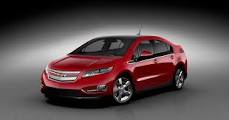Remember the Volt?
Remember the Edsel? Most readers probably don’t, as they aren’t old enough to recall car events in the late 1950s and early 1960s. But I’m a geezer, as well as a car guy. I well remember Ford’s monumental failure, producing a mid-range car designed to compete with General Motors’ Buick and Oldsmobile lines. When Ford in the 1958 model year rolled out the long-anticipated car, named for Henry Ford’s son, TIME magazine described it as looking like “an Oldsmobile sucking a lemon.” 1960 was the last model for the Edsel.
I raise the specter of the Edsel to talk about GM’s own, much more recent failure, the Chevy Volt plug-in hybrid. A provocative Bloomberg article caught my eye this week, where author Edward Niedermeyer likenes the failure of the Volt to the lackluster end days of the Obama presidency. I’m not going to go there, except to note that president, at a time when the federal government effectively owned GM, raised the expectations for the plug-in Volt far beyond what was possible.
But he wasn’t alone. The electric utility industry was also hyping the Volt as the greatest automotive innovation since the Model T. Unlike the Toyota Prius and other hybrids which generated the electric portion of their power trains on their own – providing no benefits to utilities – the Volt would produce new electric load just when the industry could use it. Plug-ins could help flatten the demand curve.
Not to be. The Bloomberg article notes that GM (before the Great Recession) had planned on selling only 30,000 Volts per year. It was going to be a car aimed at burnishing the company’s tarnished image more than generating sales and profits. Thanks to hype in Obama’s 2011 State of the Union address (and all SOTU addresses by all presidents in recent years are simply hype machines designed to prompt standing ovations), GM ended up committing to plans for sales of 120,000 Volts annually.
After four years on the market, the Volt has managed total sales of only 70,000 cars – even with generous federal subsidies. It is seen, properly, as a failure and GM has suspended production for four weeks in June and July because of poor sales. The New York Times reports, “Through March, G.M. sold only 1,874 Volts, down 48 percent from a year ago.”
In the years that the Volt has been for sale, I saw my first Volt actually on the road last January on my way to the airport. I haven’t seen any since. Based on what I’ve read about it, the Volt is a $20,000 car with a $40,000 sticker price. (I also saw my first $70,000 Tesla on the road just two weeks ago, near Harpers Ferry, W.Va., not far from where I live. There was nothing impressive about it from the outside.)
GM plans to roll out a second-generation Volt sometime soon and is working on an all-electric car, dubbed the Bolt. Don’t bet on the Bolt. I doubt the company will be able to solve the problem of getting an adequate battery that will convince a large number of motorists to give up on cheap and ubiquitous gasoline. Filling the tank takes five minutes, compared to hours to charge a plug-in or fully-electric car.
President Obama has said he will buy a Volt when he leaves the White House, Bloomberg reported. He might get better value with a vintage Edsel, with the pushbutton transmission selector in the middle of the steering wheel.
